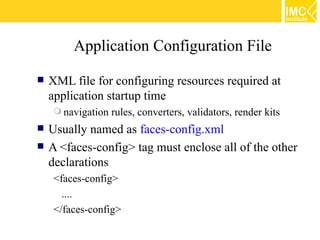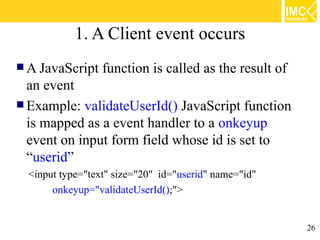Java Web Programming [8/9] : JSF and AJAX
- 1. Module 8: JSF and AJAX Basics Thanisa Kruawaisayawan Thanachart Numnonda www.imcinstitute.com
- 2. Objectives What is JSF? Real-Life Examples of AJAX Apps What is AJAX and Why AJAX? Technologies Used In AJAX XMLHttpRequest 2
- 3. JavaServer™ Faces (JSF) Framework Is… A server side user interface (UI) component framework for Java™ technology-based web applications. (Validators) Drag-and-drop UI components to build a web Application.
- 4. Application Configuration File XML file for configuring resources required at application startup time navigation rules, converters, validators, render kits Usually named as faces-config.xml A <faces-config> tag must enclose all of the other declarations <faces-config> .... </faces-config>
- 5. Two Tag Libraries jsf_core Definesother JSF related tags Independent of any rendering technology html_basic Defines tags for representing common HTML user interface components JSP page need to declare them <%@ taglib uri="http://java.sun.com/jsf/core/" prefix="f" %> <%@ taglib uri="http://java.sun.com/jsf/html/" prefix="h" %>
- 6. <f:view> element Represents UIViewRoot component All component tags on the page must be enclosed in the view tag <f:view> ... other faces tags, possibly mixed with other content ... </f:view> Optional locale attribute Overrides the Locale stored in the UIViewRoot
- 7. HTML Tags Used to control display data or accept data from the user Common attributes id:uniquely identifies the component value: identifies an external data source mapped to the component's value binding: identifies a bean property mapped to the component instance
- 8. Built-in UI Component Classes UIForm: Encapsulates a group of controls that submit data to the application. This component is analogous to the form tag in HTML. UIInput: Takes data input from a user is a subclass of UIOutput UIOutput: Displays data output on a page
- 9. UIForm & <h:form> tag UIForm UI component An input form with child components representing data that is either presented to the user or submitted with the form Encloses all of the controls that display or collect data from the user Include HTML markup to layout the controls on the page <h:form> tag itself does not perform any layout
- 10. UIInput & UIOutput Components UIInput component displays a value to a user and allows the user to modify this data The most common example is a text field UIOutput component displays data that cannot be modified The most common example is a label Conversions can occur Both UIInput and UIOutput components can be rendered in several different ways
- 11. UICommand & <h:commandButton> UICommand component performs an action when it is activated Most common renderers are Button and Link
- 12. UICommand & <h:commandButton> Additional attributes action: is either a logical outcome String or a JSF EL expression that points to a bean method that returns a logical outcome String In either case, the logical outcome String is used by the navigation system to determine what page to access when the UICommand component is activated
- 13. Example1: <h:commandButton> from carDetail.jsp <h:commandButton action="#{carstore.buyCurrentCar}" value="#{bundle.buy}" /> action attribute references a method on the CarStore backing bean that performs some processing and returns an outcome outcome is passed to the default NavigationHandler, which matches the outcome against a set of navigation rules defined in the application configuration file. value attribute references the localized message for the button's label bundle part of the expression refers to the ResourceBundle that contains a set of localized messages
- 14. greeting.jsp <f:view> <h:form id="helloForm" > <h2>Hi. My name is Duke. I'm thinking of a number from <h:outputText value="#{UserNumberBean.minimum}"/> to <h:outputText value="#{UserNumberBean.maximum}"/>. Can you guess it? </h2> <h:graphic_image id="waveImg" url="/wave.med.gif" /> <h:inputText id="userNo" value="#{UserNumberBean.userNumber}“ /> <h:commandButton id="submit" action="success" value="Submit" /> <p> <h:messages style="color: red; font-family: 'New Century Schoolbook', serif; font-style: oblique; text-decoration: overline" id="errors1" for="userNo"/> </h:form> </f:view> </HTML>
- 15. Validation Model jsf-core tag library also defines a set of tags that correspond to the standard Validator implementations Most of the tags have a set of attributes for configuring the validator's properties minimum and maximum
- 16. Validator Tags <f:validator> Registers a custom Validator on a component <f:validateLength> Registers a LengthValidator on a component <f:validateLongRange> Registers a LongRangeValidator on a component <f:validateDoubleRange> Registers a DoubleRangeValidator on a component
- 17. Real-Life Examples of AJAX Apps Google maps http://maps.google.com/ Google Suggest http://www.google.com/webhp?complete=1&hl=en Gmail http://gmail.com/ Yahoo Maps (new) http://maps.yahoo.com/ Many more are popping everywhere 17
- 18. What is AJAX? Asynchronous JavaScript And XML DHTML plus Asynchronous communication capability through XMLHttpRequest Pros Most viable RIA technology so far Tremendous industry momentum Several toolkits and frameworks are emerging No need to download code & no plug-in required Cons Still browser incompatibility JavaScript is hard to maintain and debug 18
- 19. Why AJAX? Intuitive and natural user interaction Noclicking required Mouse movement is a sufficient event trigger "Partial screen update" replaces the "click, wait, and refresh" user interaction model Only user interface elements that contain new information are updated (fast response) The rest of the user interface remains displayed without interruption (no loss of operational context) Asynchronous communication replaces "synchronous request/response model." 19
- 20. Interrupted user operation while the data is being fetched Uninterrupted user operation while data is being fetched 20
- 21. 21
- 22. Server-Side AJAX Request Processing Server programming model remains the same It receives standard HTTP GETs/POSTs Can use Servlet, JSP, JSF, ... With minor constraints More frequent and finer-grained requests from client Response content type can be text/xml text/plain text/json text/javascript 22
- 23. Demo Scenario Runsample AJAX applications within NetBeans IDE Auto completion Data validation Progress bar You can try this demo yourself These applications are provided as built-in sample applications in NetBeans 23
- 24. Data Validation Example 24
- 25. Steps of AJAX Operation 1. A clientevent occurs 2. An XMLHttpRequest object is created 3. The XMLHttpRequest object is configured 4. The XMLHttpRequest object makes an async. request 5. The ValidateServlet returns an XML document containing the result 6. The XMLHttpRequest object calls the callback() function and processes the result 7. The HTML DOM is updated 25
- 26. 1. A Client event occurs A JavaScript function is called as the result of an event Example: validateUserId() JavaScript function is mapped as a event handler to a onkeyup event on input form field whose id is set to “userid” <input type="text" size="20" id="userid" name="id" onkeyup="validateUserId();"> 26
- 27. 2. An XMLHttpRequest object is created var req; function initRequest() { if (window.XMLHttpRequest) { req = new XMLHttpRequest(); } else if (window.ActiveXObject) { isIE = true; req = new ActiveXObject("Microsoft.XMLHTTP"); } } function validateUserId() { initRequest(); req.onreadystatechange = processRequest; if (!target) target = document.getElementById("userid"); var url = "validate?id=" + escape(target.value); req.open("GET", url, true); req.send(null); } 27
- 28. 3. An XMLHttpRequest object is configured with a callback function var req; function initRequest() { if (window.XMLHttpRequest) { req = new XMLHttpRequest(); } else if (window.ActiveXObject) { isIE = true; req = new ActiveXObject("Microsoft.XMLHTTP"); } } function validateUserId() { initRequest(); req.onreadystatechange = processRequest; // callback function if (!target) target = document.getElementById("userid"); var url = "validate?id=" + escape(target.value); req.open("GET", url, true); req.send(null); 28 }
- 29. 4. XMLHttpRequest object makes an async. request function initRequest() { if (window.XMLHttpRequest) { req = new XMLHttpRequest(); } else if (window.ActiveXObject) { isIE = true; req = new ActiveXObject("Microsoft.XMLHTTP"); } } function validateUserId() { initRequest(); req.onreadystatechange = processRequest; if (!target) target = document.getElementById("userid"); var url = "validate?id=" + escape(target.value); req.open("GET", url, true); req.send(null); } URL is set to validate?id=greg 29
- 30. 5. The ValidateServlet returns an XML document containing the results (Server) public void doGet(HttpServletRequest request, HttpServletResponse response) throws IOException, ServletException { String targetId = request.getParameter("id"); if ((targetId != null) && !accounts.containsKey(targetId.trim())) { response.setContentType("text/xml"); response.setHeader("Cache-Control", "no-cache"); response.getWriter().write("<valid>true</valid>"); } else { response.setContentType("text/xml"); response.setHeader("Cache-Control", "no-cache"); response.getWriter().write("<valid>false</valid>"); } } 30
- 31. 6. XMLHttpRequest object calls callback() function and processes the result The XMLHttpRequest object was configured to call the processRequest() function when there is a state change to the readyState of the XMLHttpRequest object function processRequest() { if (req.readyState == 4) { if (req.status == 200) { var message = ...; 31
- 32. 7. The HTML DOM is updated JavaScript technology gets a reference to any element in a page using DOM API The recommended way to gain a reference to an element is to call document.getElementById("userIdMessage"), where "userIdMessage" is the ID attribute of an element appearing in the HTML document JavaScript technology may now be used to modify the element's attributes; modify the element's style properties; or add, remove, or modify child elements 32
- 33. 1. <script type="text/javascript"> 2. function setMessageUsingDOM(message) { 3. var userMessageElement = document.getElementById("userIdMessage"); 4. var messageText; 5. if (message == "false") { 6. userMessageElement.style.color = "red"; 7. messageText = "Invalid User Id"; 8. } else { 9. userMessageElement.style.color = "green"; 10. messageText = "Valid User Id"; 11. } 12. var messageBody = document.createTextNode(messageText); 13. // if the messageBody element has been created simple replace it otherwise 14. // append the new element 15. if (userMessageElement.childNodes[0]) { 16. userMessageElement.replaceChild(messageBody, 17. userMessageElement.childNodes[0]); 18. } else { 19. userMessageElement.appendChild(messageBody); 20. } 21. } 22. </script> 23. <body> 24. <div id="userIdMessage"></div> 25. </body> 33
- 34. Acknowledgement Most contents are borrowed from the presentation slides of Sang Shin, Java™ Technology Evangelist, Sun Microsystems, Inc. 34
- 35. Thank you [email protected] www.facebook.com/imcinstitute www.imcinstitute.com 35

































![1. <script type="text/javascript">
2. function setMessageUsingDOM(message) {
3. var userMessageElement = document.getElementById("userIdMessage");
4. var messageText;
5. if (message == "false") {
6. userMessageElement.style.color = "red";
7. messageText = "Invalid User Id";
8. } else {
9. userMessageElement.style.color = "green";
10. messageText = "Valid User Id";
11. }
12. var messageBody = document.createTextNode(messageText);
13. // if the messageBody element has been created simple replace it otherwise
14. // append the new element
15. if (userMessageElement.childNodes[0]) {
16. userMessageElement.replaceChild(messageBody,
17. userMessageElement.childNodes[0]);
18. } else {
19. userMessageElement.appendChild(messageBody);
20. }
21. }
22. </script>
23. <body>
24. <div id="userIdMessage"></div>
25. </body> 33](https://image.slidesharecdn.com/javaweb-module8-130106070914-phpapp02/85/Java-Web-Programming-8-9-JSF-and-AJAX-33-320.jpg)

